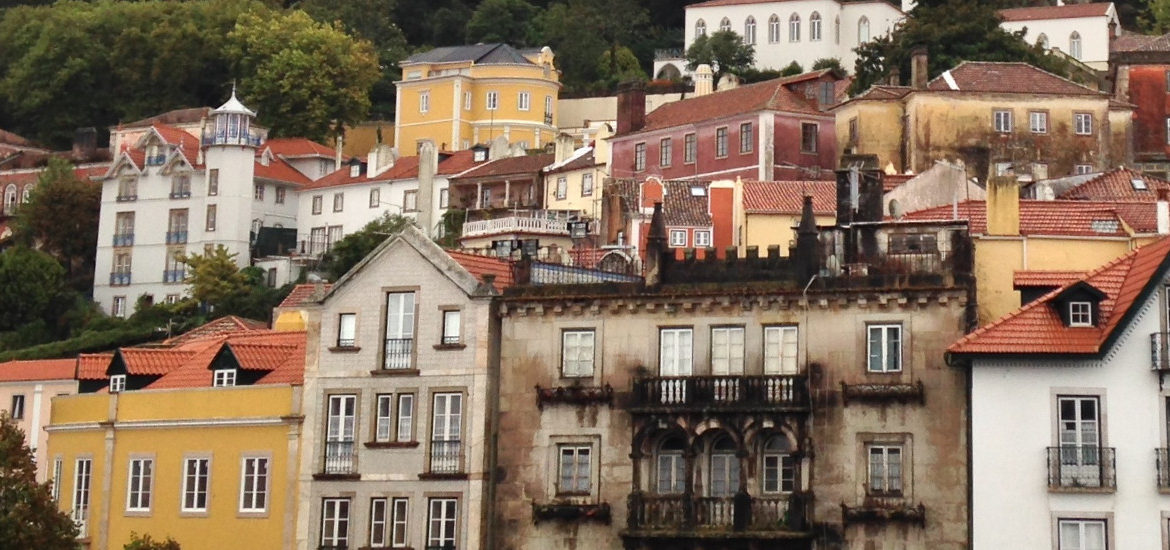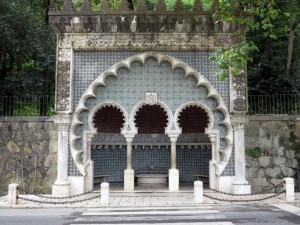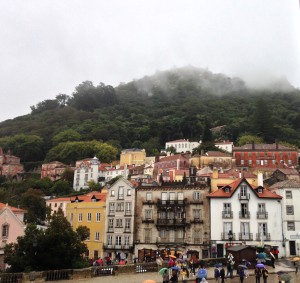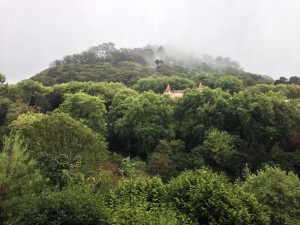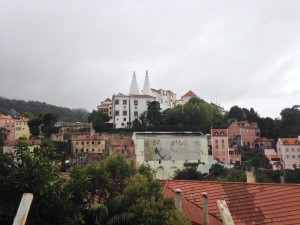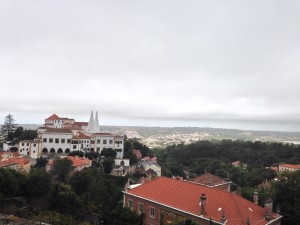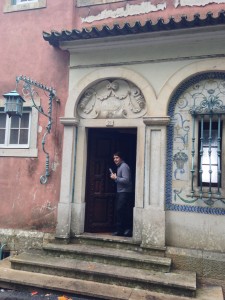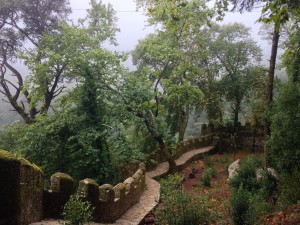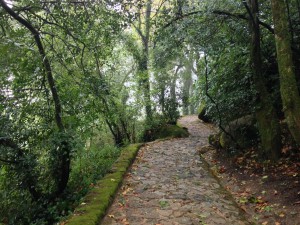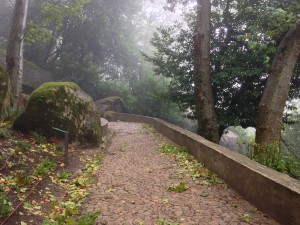Sintra, Portugal
Thursday, 26 September 2013
We arrived in Lisbon by train from Porto on Thursday 26 September 2013. We were not happy with our initial booking at the Beach Destination Hostel. We wanted to cancel our booking because they could not provide the rooms that we had pre-booked. They offer some dark crappy alternatives and when we did not want that, they did not want to give back the deposit. We put up a fight and only got response when I said that I would write a review on the website of the hostel. Suddenly the manager/owner appeared, gave back the deposit and also remarked that he did not need customers like us. I must say the differences between the images and descriptions on the website and the real thing was disconcerting. We had to find other accommodation for the night and in the meantime, a friend would be arriving at the Lisbon airport from London to spend a few days in Lisbon with us. We were stressed and as usual the iPhone was used to solve our out of accommodation problem, not to satisfaction because most of the places were fully booked, or too expensive, it was weekend, late on a Friday afternoon and we were pressed for time and it was raining and we were tired and we were fed-up with the situation. We were forced to book at available affordable places, which seemed later on also not a very good choice but anyway bett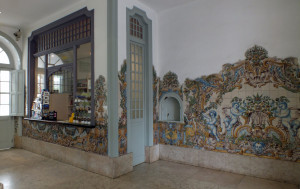 er than the Beach Destination Hotel. Later the friend arrived at our hotel at own means because by the time we reached our alternative accommodation the airplane had already landed. After unpacking and a little rest we went out for dinner.
er than the Beach Destination Hotel. Later the friend arrived at our hotel at own means because by the time we reached our alternative accommodation the airplane had already landed. After unpacking and a little rest we went out for dinner.
The following day we went to Sintra. We took the train from Rosso station to Sintra, and arrived after a 45-minute trip at Sintra station, beautifully decorated with the well-known Portuguese Azulejo tiles.
We planned to see the town of Sintra and some of the sightseeing attractions. We walked from the railway station to the centre of the town passing the Sculpture at Volta Duche Street. We walked about 2 km in a lane decorated with amazing contemporary statues. Volta do Duche is one of the best-known areas in Sintra. I regret not taking more photos.
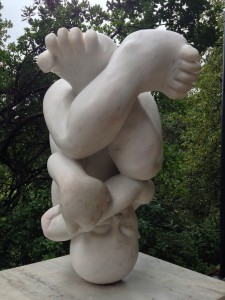 Somewhere between the Sintra station and the town of Sintra, we must have walked through an invisible mystical curtain. While walking I felt as being in another world, a mystical world. The misty, cloudy weather played a key role in creating this enchanted atmosphere. Sintra is one of those magic places where nature and man are in a perfect synergy, creating amazing results that could not leave you spiritually untouched. We walked past the well-known Fountain Mourisca a Moorish-style fountain, neo-mudejar, built in 1922 by local sculpture Jose de Fonseca and is beautiful decorated and tiled.
Somewhere between the Sintra station and the town of Sintra, we must have walked through an invisible mystical curtain. While walking I felt as being in another world, a mystical world. The misty, cloudy weather played a key role in creating this enchanted atmosphere. Sintra is one of those magic places where nature and man are in a perfect synergy, creating amazing results that could not leave you spiritually untouched. We walked past the well-known Fountain Mourisca a Moorish-style fountain, neo-mudejar, built in 1922 by local sculpture Jose de Fonseca and is beautiful decorated and tiled.
Volta do Duche displays annually the largest exhibition of outdoor sculpture in the world, known as “Sintra Public Art”. On specific days between August and October every year the Volta do Duche is also invaded by artisans from around the county, displaying traditional arts and crafts of Sintra.
We reached the old town of Sintra. Several public buildings of a cultural and social nature are located in the historical centre, Vila Velha. Built at the foot of the mountain, in a sloping area, the Vila Velha developed between the National Place and the mountain. There is a large public square adjacent to the Palace. The Vila Velha has a population of around 400 people, mostly aged and without large financial resources. The influx of tourists has been a determining factor in the predominance of shops selling handicrafts and regional articles, as well as in the growing number of restaurants and bars that have been opening here. Traces of the Moors and Jews past can still be found in the names of some streets and squares. It was reconstructed after the 1755 earthquake. As in Lisbon, most of the Vila buildings were partially or completely destroyed.
Our first stop was the Palácio Nacional de Sintra (Sintra National Palace). The Palácio Nacional de Sintra, also known as Paço Real or Palácio da Vila, dominates the entire urban centre of Sintra. King John I built the palace at the end of the 14th century, probably on the remains of an old Moorish castle. In the beginning of the 16th century, it was rebuilt by King Manuel I, in a mix of different styles. With its two unusual chimneys, the Palace is nowadays the setting for many concerts of classical music, official receptions and historical pageants. Personally I was not much impressed with this palace. It did not enhance the overall mystical fairy-tale feeling.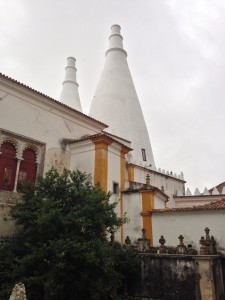
I can understand why Sintra is nowadays the setting for several events where art fuses with the landscape. One such event is the Sintra Music Festival that takes classical music to open air spaces, creating an intimate and reciprocal relationship between the artist, the audience and nature. There are also the Ballet evenings in the magnificent setting of the Seteais Gardens, a mixture of magic, colour and movement in which the mysterious mists, the play of water and greenery contribute to transcending to a mystical world of dreams.
During the 19th century, Sintra were visited by many Portuguese and foreign travellers, writers and aristocrats and Sintra became a favourite place of residence in the Portugal. They brought with them romantic ideals that resulted in the renovation and construction of mansions. Sintra acquired the status of a bourgeois village dedicated mainly to leisure and pleasure, and several hotels and boarding houses were immortalized by famous writers of that time. Wealthy people came to live on the periphery of the town, bringing the latest architectural trends with them, especially revivalism and eclecticism that influenced traditional architecture.
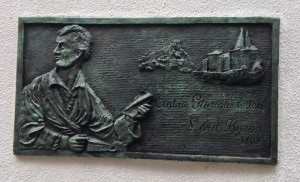 After our visit to the Palace, we explored the ancient streets of Sintra. In one of the narrow streets of the old historic centre, we walked past a commemorative plaque of Lord Byron an English poet and a leading figure in the Romantic Movement. He visited Portugal and in a letter wrote in 1908 to a friend, he described his mastery of the Portuguese language, consisting mainly of swearing and insults and that he particularly enjoyed his stay in Sintra. He described Sintra as “glorious Eden” and as “the most beautiful in the world.”
After our visit to the Palace, we explored the ancient streets of Sintra. In one of the narrow streets of the old historic centre, we walked past a commemorative plaque of Lord Byron an English poet and a leading figure in the Romantic Movement. He visited Portugal and in a letter wrote in 1908 to a friend, he described his mastery of the Portuguese language, consisting mainly of swearing and insults and that he particularly enjoyed his stay in Sintra. He described Sintra as “glorious Eden” and as “the most beautiful in the world.”
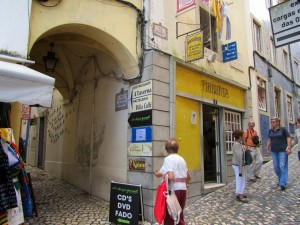 In the Rua das Padarias, we stopped for a coffee break at Pastelaria Periquita, where you can buy travesseiros, almond cookies. Besides these, Sintra is also known for its queijadas, delicious cakes.
In the Rua das Padarias, we stopped for a coffee break at Pastelaria Periquita, where you can buy travesseiros, almond cookies. Besides these, Sintra is also known for its queijadas, delicious cakes.
We strolled uphill, following a group of French speaking tourists, we followed them into a mansion that we thought to be a tourist attraction. We were surprised to be welcomed by a host at the door, telling us where to put our bags and jackets, where the toilets where. We put down our bags, visited the bathroom dated from the 18th century, typically of a prosperous family, that seemed still to have the original enormous white enamelled steel bath, washbasin and toilet. A butler with a tray offered us glasses of sherry. We helped ourselves and walked out on the balcony to appreciate the wonderful view of the garden below. In the dining room, we saw nicely laid out tables with hors d’oeuvres, buffet style and softly playing classical music in the background. I became more confused by the situation until our friend, that could understand French, softly informed us that we actually gate-crashing a conference. We emptied our glasses, discreetly took our bags and jackets and as casual as possible tried to walk out of the door where the host wanted to know why we are leaving so soon.
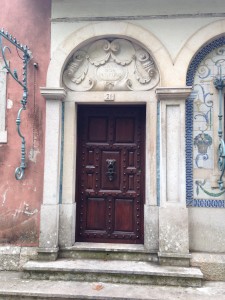
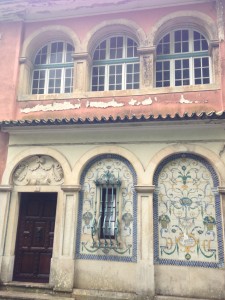
Outside we had a good laugh. Later we found out that the place is called Casa dos Penedos (House of Rocks). It was built in the last century by one of the great masters of Portuguese architecture, Raul Lino. Casa dos Penedos was built on rocks on the cliff flanked by a lake. In the charming lush garden, the arches supporting the house add to the unique setting with the sea on the horizon and a fantastic view of town when standing on the terrace. This place supports the romanticism and the botanical features of Sintra.
Today it is used for Estoril meetings, conferences, social occasions and is a sought after venue for gay weddings.
After the comical sherry stop, we continued strolling uphill towards the 9th century Moorish castle. We walked the partly off-road route via Rua Marechal Saldanha. The road was winding steeply uphill for around 2 km, but quiet, rewarding and breath taking. The misty cloudy weather made it even more pleasant and we could see the mist-covered castle ruins loomed high above the surrounding forest. The forest is a mixture of oak, pine and chestnut. The path was cobbled, next to moss-covered boulders. Ferns densely covered the caverns and climbers were straggling up the trees in the way of tropical rain forests. The pathways were slippery because of the moist weather.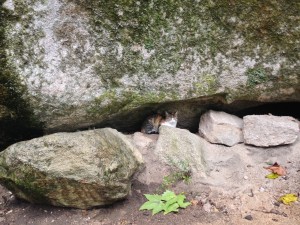
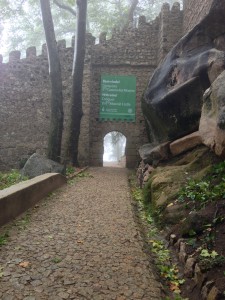 We reached the entrance to the castle where the cashier and assistant tried to talk us out of buying tickets for the entrance to the castle. He argued that it was foggy, that we would not be able to see far and that the pathways were slippery and unsafe. We convinced him that we walked all the way up not for nothing and would not blame them if anything happened to us. He reluctantly sold the tickets, emphasizing that it is solely on our own risk.
We reached the entrance to the castle where the cashier and assistant tried to talk us out of buying tickets for the entrance to the castle. He argued that it was foggy, that we would not be able to see far and that the pathways were slippery and unsafe. We convinced him that we walked all the way up not for nothing and would not blame them if anything happened to us. He reluctantly sold the tickets, emphasizing that it is solely on our own risk.
The Moorish Castle, soaring 412 m above sea level, overlooking Sintra, had its beginnings as a military fort, believed to date back to the period of Arab occupation. It served as a superb observation post for monitoring the coastline for attack, and because of its cliff-top location, it was hard to attack and easy to defend. The Moors built a large underground water reservoir inside the castle that played a vital role when the castle was under siege.
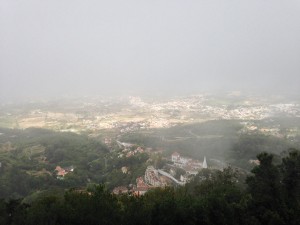
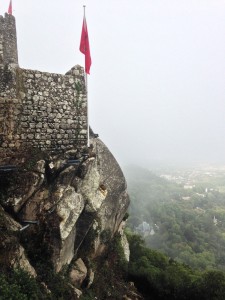
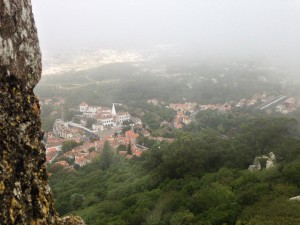
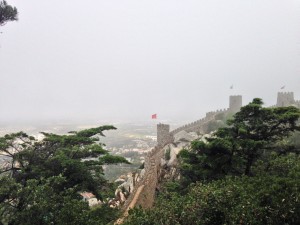
We explored the area with the small church, the cistern and the ruins. Although it is mostly in ruins, the walls still remain and offer sweeping views of the surrounding countryside. We headed towards the edge of the hill and walked along on the pathway inside the wall, climbing the small rock steps to be rewarded by breath-taking views of the surrounding area. Today the castle is classified as a National Monument, part of the Sintra Cultural Landscape and a UNESCO World Heritage Site.
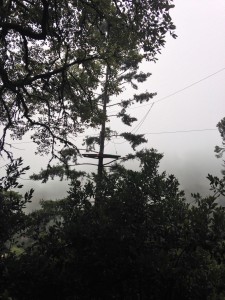 One a nice day one can take part in the Sintra Canopy tour to see the Sintra forest from above. It is an activity that allows participants to take a zipline tour, using the slide technique, between platforms built on the tops of trees along the hillside of the Moorish Castle as seen on this photo.
One a nice day one can take part in the Sintra Canopy tour to see the Sintra forest from above. It is an activity that allows participants to take a zipline tour, using the slide technique, between platforms built on the tops of trees along the hillside of the Moorish Castle as seen on this photo.
We walked back through the misty moss-clad boulders still feeling to be in a fairy-tale world. On our way down the hill from the Moorish Castle to the old town, we walked past the house where fairy-tale writer Hans Christian Andersen stayed in Sintra as a guest of the O’Neill family from 26 July to 8 August 1866. He was one of those who were attracted to the magical town of Sintra, who called the town the “most beautiful place in Portugal”.
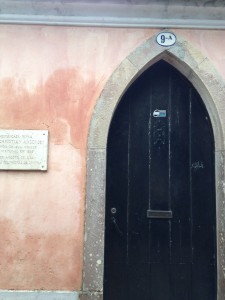
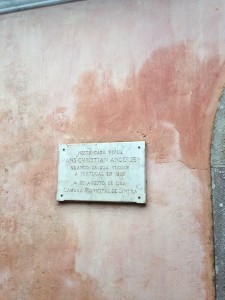
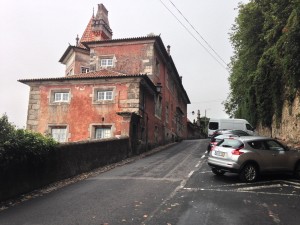
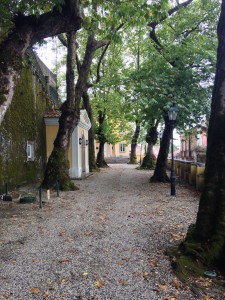
We had a nice lunch at a restaurant located in the historical centre, Vila Velha near the large public square adjacent to the Palace. We could not see all the attractions in the time we were in Sintra, for instance we did not visit the Pena National Palace and Pena Park. We walked back to the Sintra station and took the train back to Lisbon. Early the next morning I said goodbye to my daughter and took the airport bus to the airport to fly back to South Africa. This was the end of a great journey that will continue through my life. The Camino is a journey that would only end when you stop walking.
